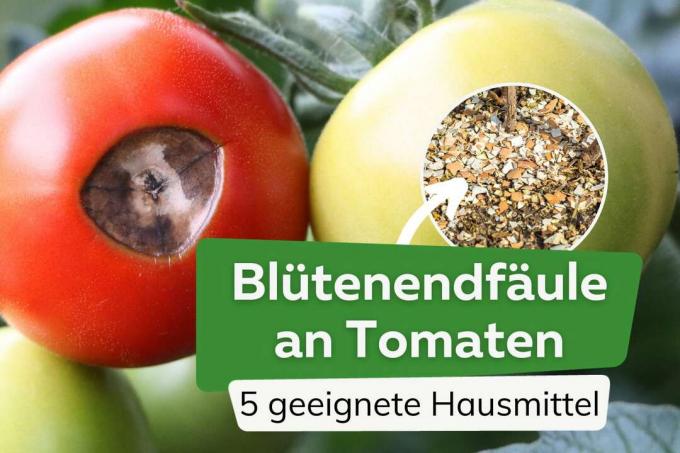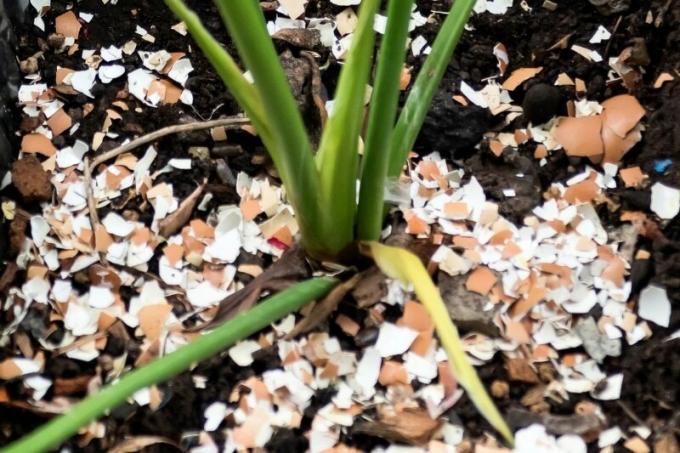
Rotten and brown spots at the base of the flowers are a sign of the occurrence of blossom end rot on various vegetables. This is not a disease, but a nutrient deficiency. Various home remedies help against blossom end rot on tomatoes.
In a nutshell
- Calcium and water deficiency causes blossom end rot
- affected fruit still edible
- Calcium effervescent tablets quickly ensure that the fruit is supplied with calcium
- Egg shells, rock flour, algae and garden lime provide the necessary nutrients
- Sufficient watering and balanced fertilization prevent blossom end rot
Table of contents
- Cause: Incorrect care
- Identify blossom end rot
- Appropriate home remedies
- algae lime
- rock flour
- eggshells
- Calcium effervescent tablets
- garden lime
- frequently asked Questions
Cause: Incorrect care
Blossom end rot is not tomato disease, but is caused by inadequate supply and care errors. Ripening tomatoes are particularly affected. The main causes of blossom end rot are
- calcium deficiency
- lack of water
- over-fertilization
Calcium ensures stable cell walls and is important for the formation of healthy fruit. If the plant is given too little calcium, the leaves are always supplied first and then the fruits. However, calcium deficiency is not always due to the fact that there is too little in the soil. Often the tomatoes simply cannot absorb the nutrient. The reason for this is a lack of water, because the plant only absorbs the dissolved nutrients from the soil with the water.

Furthermore, over-fertilization, mainly with magnesium and potassium, can block the absorption of calcium, even if there is enough available. Furthermore, excessive nitrogen fertilization ensures lush leaf growth. All of the calcium is then directed into the leaves. This is very common with fast-growing tomato varieties.
Tip: Regular watering and a balanced fertilization, beginning in spring with a dose of organic fertilizers as a basic supply, can prevent blossom end rot in tomatoes.
Identify blossom end rot
Blossom end rot does not necessarily affect all tomatoes on a truss. It usually occurs sporadically. Symptoms are often first seen on the bottom fruit.

The first signs of the occurrence of deficiency symptoms can be:
- initially watery, small, brown dots on the underside of the inflorescence of a fruit
- later sunken, brown and leathery hard patches
- Fruits begin to rot in these places
- sometimes deformed and brown leaves present
A notice: Blossom end rot should not be confused with early blight, which is caused by the fungus Alternaria solani. In addition to leaf spots with concentric rings, brown and rotten spots are also visible on the fruit. However, these have concentric rings.
Appropriate home remedies
Do not immediately use chemical remedies to combat the nutrient deficiency, since you still want to eat the fruit. There are also some home remedies that have proven effective against blossom end rot on tomatoes, which you either already have at home or can easily get from a drugstore or hardware store.
algae lime

Algae lime supplies many nutrients, loosens the soil, neutralizes the soil, has an alkaline effect and raises the pH value. The lime is obtained from collagen deposits in the red algae. It consists of 80 percent carbonate of lime - calcium carbonate (CaCO3), as well as magnesium, manganese, iodine and boron. The lime is available as granules or powder.
- Use weekly throughout the growing season
- 200 to 300 grams per square meter
- Spread around plants and chop lightly
- then water well
A notice: Spraying the plants with a solution of algae lime can heal injuries to the fruit.
rock flour
This is ground rock such as basalt, diabase and other lava rock. It contains natural calcium carbonate and many additional minerals and trace elements such as boron, potassium and iron. Rock dust supplies the plants with important nutrients and improves the condition of the soil. This makes it easier for the plants to absorb nutrients.
- apply and rake in in the autumn before planting on the bed
- Dosage 100 grams per square meter
- When planting, add another teaspoonful to the planting hole
- then regular fertilization
- Dosage per plant 15 grams
- Distribute around the plant, work in lightly and water well
- Fertilization intervals of two to four weeks
eggshells

For blossom end rot on tomatoes, eggshells are a suitable home remedy because they are a very good supplier of lime. The plants can easily absorb the nutrient from the soil.
- Crumble 2 to 3 shells per plant or grind to powder in a mortar
- then spread either around the plant
- easily incorporated into the soil
- water well
- alternatively, add crushed peels to a liter of water
- let it soak for a day or two
- then water the tomato plant
- repeat weekly
Tip: With the sharp-edged shells of uncooked eggs also keep most snails out of the garden.
Calcium effervescent tablets
Calcium tablets are available in any drugstore or pharmacy. They are a good supplier of calcium. The nutrient is quickly available to the tomatoes when they are used. It can be taken up even faster by foliar fertilization.
- crush one or two tablets
- spread around the tomato plant
- lightly work into the soil and pour or
- put a tablet in the root area in the soil and give plenty of water
- alternatively, two to three tablets can be dissolved in the irrigation water
- Repeat every one to two weeks
A notice: The home remedy for blossom end rot on tomatoes is also commercially available in liquid form, consisting of calcium, manganese and zinc. It can be mixed into irrigation water or used to spray plants.
garden lime

This is carbonate of lime, i.e. natural calcium carbonate. It is ground from hard-to-dissolve limestone. It provides tomatoes with missing calcium and at the same time promotes good root development and ensures healthy growth.
- spread a teaspoon of lime around the plant
- incorporate into soil and water
- repeat if necessary
- alternatively apply 150 grams per square meter to the bed in autumn before planting
- do a soil analysis first
Tip: We recommend removing all leaves below the first infructescence. As a result, the absorbed calcium is not passed on to the leaves, but directly to the fruit.
frequently asked Questions
Because blossom end rot is not a fungal or bacterial disease, but is only a deficiency symptom, infected tomatoes can still be eaten without any problems become. Just cut out the brown spots. Only green and already infested tomatoes should be removed from the bush. This allows the plant to focus its energy on growing healthy fruit.
Blossom end rot mainly affects tomatoes, especially fast-growing varieties. and varieties with large fruits such as beefsteak tomatoes and ox hearts. In addition, paprika (Capsicum), zucchini (Curcurbita pepo var. giromontiina), cucumbers (Cucumis sativus) and chili (Capsicum) show this deficiency symptom. The same symptoms appear as with tomatoes.
Baking soda is known for its antifungal properties. However, blossom end rot is not a fungal disease. Using baking soda will not fix the nutrient deficiency, it will only increase the pH of the soil. This allows plants to better absorb calcium. On the other hand, baking soda is good for combating Late blight and late blight.

